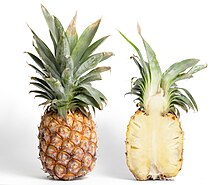


Multi-fruits, also called collective fruits, are fruiting bodies formed from a cluster of flowers, the inflorescence. Each flower in the inflorescence produces a fruit, but these mature into a single mass.[1] After flowering, the mass is called an infructescence.[2][3] Examples are the fig, pineapple, mulberry, osage orange, and jackfruit.
In contrast, an aggregate fruit such as a raspberry develops from multiple ovaries of a single flower. In languages other than English, the meanings of "multiple" and "aggregate" fruit are reversed, so that multiple fruits merge several pistils within a single flower.[4]
In some cases, the infructescences are similar in appearance to simple fruits. One example is pineapple (Ananas), which is formed from the fusion of the berries with receptacle tissues and bracts.[5][6]

As shown in the photograph of the noni, stages of flowering and fruit development in the noni or Indian mulberry (Morinda citrifolia) can be observed on a single branch. First an inflorescence of white flowers called a head is produced. After fertilization, each flower develops into a drupe, and as the drupes expand, they become connate (merge) into a multiple fleshy fruit called a syncarp. There are also many dry multiple fruits.[citation needed]
Other examples of multiple fruits: